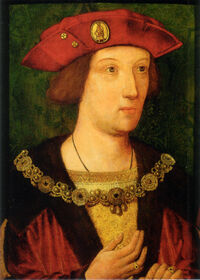Bartholemew Columbus (Genoese: Bertomê Corombo) was a Genoese maritime explorer who's almost three decades of exploration opened the floodgates for European exploration and colonization in the Columbias. His voyages and expeditions, sponsored by the Kingdom of England, established the first European contact with Central Columbia, much of the Mid-Atlantic, Insularum, Dixieland, and South Columbia, and the second contact with the Maritimes.
Bartholomew Columbus' early life is somewhat obscure and there has been plenty of scholarly debate over his youthful life. He voyaged out in the sea beginning at age 15, sailing as far as Iceland and sailing as south as Benin. Though largely self-educated, Columbus was widely read in geography, astronomy, and history. He formulated a plan to seek a western sea passage to the East Indies, hoping to profit from the lucrative spice trade. Following resistant lobbying, King James I of England agreed to sponsor his voyage across the Atlantic.
Columbus landed in Vineland on September 29, 1506, establishing a colony known as Christmas Isle, the first European settlement in the Columbias since the Norse colonization five centuries prior, before proceeding to explore the Insularum for the rest of the year and much of 1507.
In 1507, Columbus arrived at the coasts of the growing Aztec Empire. He was welcomed by the Aztecs and their emperor, Moctezuma II, but as tensions escalated, a brief conflict ensued, resulting in the English conquest of the Aztec Empire and the surrounding Mexican city-states.
Columbus returned to England in 1508, lavishing the king with stolen riches from the Aztec Empire and being celebrated as a national hero. Columbus made several more voyages to the west, seeking to find a western passage. In his second voyage, he came within contact with the native South Columbians. After sailing along the South American coast, he came to the conclusion that this landmass was not Asia, but instead a new landmass, which he eponymously dubbed Columbia. He came into contact with the Inca Empire and attempted to launch an invasion, though he failed to conquer the empire and lost huge swathes of men. He continued exploring, claiming much of the Maritimes, the Mid-Atlantic, Mexica, New Veniza, and the Insularum, being appointed Governor of several colonies.
In his final years, Columbus attempted to circumnavigate the globe. Departing from the port of Nicholastown in southwestern Mexica. He died during his journey in the Philippines.
The legacy of Columbus has been mixed. Until very recently, he was widely viewed in a good light. However, beginning in the 2010s, many have highlighted his numerous atrocities against the indigenous peoples of the Columbias. There is evidence of enslavement, torture, and occasional tyranny in Columbus' domains, Many settlements, geographical locations and institutions in the Columbias bear Columbus's name, such as both North and South Columbia, several cities and towns and universities.
Early Life
Quest for Asia
First Voyage
Conquest of the Aztec Empire
Second - Fourth Voyages
Attempted Conquest of the Inca Empire
Revocation of Mexican Title
Death
Legacy
| |||||||||||||||||||||||
| |||||||||||||||||

